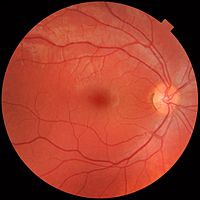
Photo from wikipedia
With the continuous development of deep learning, the performance of the intelligent diagnosis system for ocular fundus diseases has been significantly improved, but during the system training process, problems like… Click to show full abstract
With the continuous development of deep learning, the performance of the intelligent diagnosis system for ocular fundus diseases has been significantly improved, but during the system training process, problems like lack of fundus samples and uneven sample distribution (the number of disease samples is much smaller than the number of normal samples) have become increasingly prominent. In view of the previous issues, this paper proposes a method for generating fundus images based on “Combined GAN” (Com-GAN), which can generate both normal fundus images and fundus images with hard exudates, so that the sample distribution can be more even, while the fundus data are expanded. First, this paper uses existing images to train a Com-GAN, which consists of two subnetworks: im-WGAN and im-CGAN; then, it uses the trained model to generate fundus images, then performs qualitative and quantitative evaluation on the generated images, and adds the images to the original image set to expand the datasets; finally, based on this expanded training set, it trains the hard exudate detection system. The expanded datasets effectively improve the generalization ability of the system on the public datasets DIARETDB1 and e-ophtha EX, thereby verifying the effectiveness of the proposed method.
Journal Title: Mathematical Problems in Engineering
Year Published: 2020
Link to full text (if available)
Share on Social Media: Sign Up to like & get
recommendations!